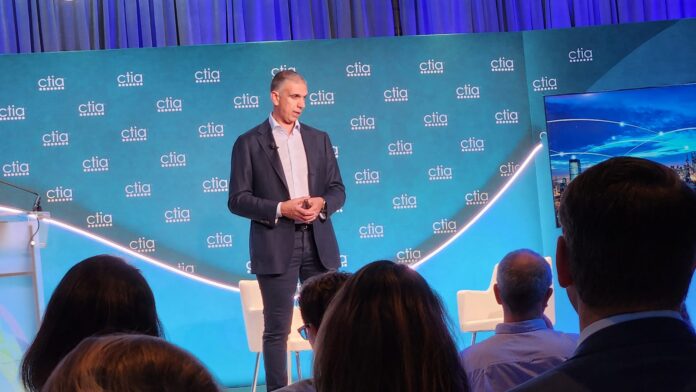WASHINGTON, D.C.—The refrain came again and again over the course of the afternoon, from carriers, network equipment makers and other industry players: Spectrum is the lifeblood of wireless, and the future of the telecommunications, the technological leadership of the United States, and the country’s economic and national security are at risk if the federal government doesn’t come up with a comprehensive, long-term spectrum plan and pipeline, and restore the Federal Communications Commission’s authority to auction spectrum.
Top executives from Samsung, Ericsson, Nokia, Verizon, AT&T, T-Mobile US and more echoed those points in sessions at the CTIA 5G Summit held yesterday at the International Spy Museum.
While praising the FCC’s work on bringing the C-Band and 3.45-3.55 GHz spectrum to market, Igal Elbaz, AT&T’s network CTO, told the audience that the carrier has seen a 200% increase in the amount of data carried across its global network in the past five years, and that it expects to see a projected 5x data increase in traffic based on the time period from 2021 to 2025. “In order for us to keep up with demand, we need full-power, licensed midband spectrum,” said Elbaz.
Mark Louison, EVP and GM of Samsung Electronics Americas’ network business, said that he sees three major topics at the forefront for the wireless industry: Spectrum, closing the digital divide and how to architect networks in the face of seemingly insatiable mobile data demands.
Niklas Heuveldop, president and CEO of Ericsson North America, reminded the audience at the International Spy Museum that the mobile industry is “not anywhere near done” with the 5G build-out. “There is a lot more to 5G than what we have been able to deliver at this point in time as an industry,” he added. In particular, he singled out the device and application ecosystems are lacking, with only a small percent of 5G devices taking form factors other than smartphones, and a limited percentage of the global 5G device base available in the U.S. Even within Ericsson’s own smart factory in Lewisville, Texas, he shared, the company runs autonomous guided vehicles—with the 5G components strapped on to prove the use case, because the chipsets and modules aren’t natively built-in to such equipment yet.
Additionally, while 5G is spreading more rapidly than LTE before it, he said that “only a handful of countries” have gotten to the point of 5G availability for 70% or more of their population. “That’s when things start happening—when you have your customers’ attention,” Heuveldop said.
However, he gave 5G credit for driving 3-5% topline growth across Ericsson’s customers in recent quarters, based solely on upgrading cellular devices and plans. In addition, the fastest-growing fixed broadband service is Fixed Wireless Access, which is providing “real, meaningful new business” and new revenues, he added; there are now about 5 million FWA customers in the U.S. and Heuveldop sees it as a global phenomena that will spread and be particularly useful for closing the digital divide around the world.
He said that 4G witnessed the digitalization of the consumer, and he is optimistic about the digitalization of enterprise in 5G. “We are not where we need to be, but we are in a very intense period of experimentation,” he said, adding that Ericsson is working on “hundreds” of pilot projects and proofs-of-concepts for private networks across the U.S., ranging from mining and manufacturing to smart cities, oil & gas uses and healthcare, among others. In contrast, he said that across the three operators in China, there have been 5,000 private networks sold and another 25,000 on-order—in other words, a level of industrialization of networks that the U.S. has not yet reached.
China was top of mind during the course of the afternoon particularly its potential to outflank the U.S. on international standards, spectrum availability and control of the internet beyond its borders. Anne Neuberger, deputy national security advisor for cyber and emerging technology for the National Security Council, said that 5G and 6G “don’t only represent the future of mobile,” but that they “represent the future of the internet more broadly” because of expected increase of not only mobile usage, but closer interconnections and interworkings with satellite and other types of networks. China, she said, is the only country with both the goal and the ability to reshape the global technology order, including through standards activities that reflect its worldview and subsidizing its domestic vendors so that they are the most cost-effective option. If the U.S. doesn’t get its spectrum policy right, Neuberger said, the country will face risk to both its national and economic security.
Jessica Rosenworcel, chairwoman of the FCC, took to the stage to speak with CTIA President and CEO Meredith Attwell Baker and reiterated the bipartisan nature of the support for Congress to re-establish the agency’s auction authority, as well as the fruits of that authority: 100 auctions held, more than $233 billion raised for the U.S. Treasury, and thousands of megahertz of spectrum, both licensed and unlicensed, made available for commercial uses that spur economic growth.
However, despite repeated pleas from Rosenworcel and her FCC colleagues, carriers like T-Mobile US (which has yet to have its recently won 2.5 GHz licenses transferred to its control) and industry advocacy groups, the FCC’s authority has yet to be reinstated, and there is no sense of how quickly or when that might happen.

